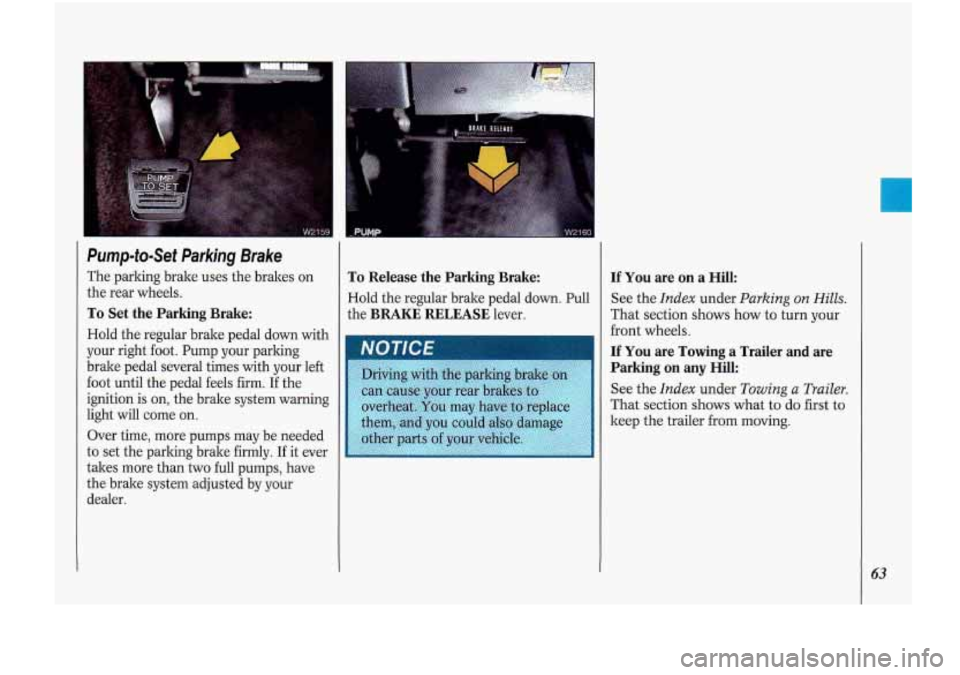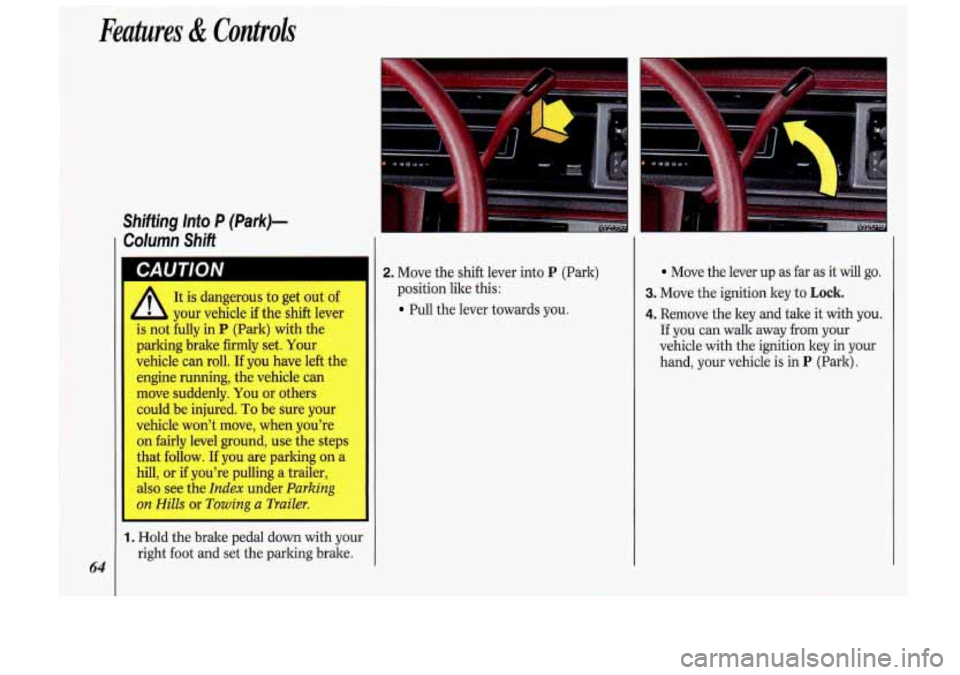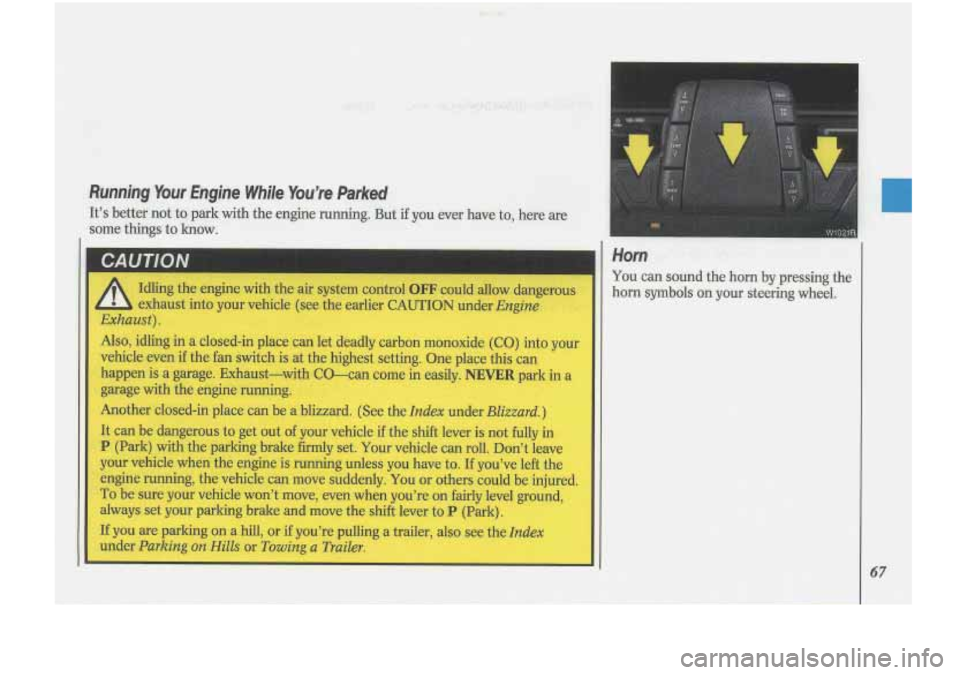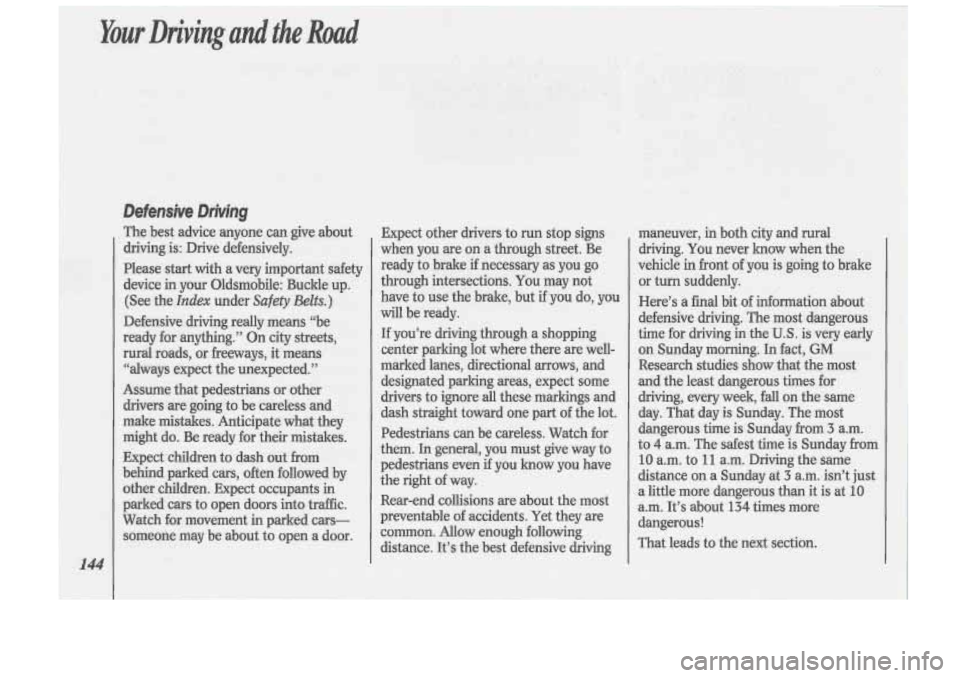parking brake Oldsmobile Cutlass Supreme 1993 Owner's Manuals
[x] Cancel search | Manufacturer: OLDSMOBILE, Model Year: 1993, Model line: Cutlass Supreme, Model: Oldsmobile Cutlass Supreme 1993Pages: 340, PDF Size: 16.21 MB
Page 61 of 340

Park
P (Park): This loclcs your front
wheels. It’s the best position
to use
when you start your engine because
your vehicle can’t move easily.
A
I It is dangerous to get out of your vehicle if the shift lever is not fully in
P (Park) with the parking brake firmly set. Your vehicle can roll.
Don’t leave your vehicle when the engine
is running unless you have to. If you
have left the engine running, the vehicle can move suddenly. You or others
could be injured.
To be sure your vehicle won’t move, when you’re on fairly
level ground, always set your parking brake and move the shift lever to
P (Park).
See the
Index under Shifting Into P (Park). If you are parking on a hill, or if
you’re pulling a trailer, also see the
Index under Parking on Hills or Towing a I
Trailer. I
59
Page 65 of 340

Pump-to-Set Parking Brake
The parking brake uses the brakes on
the rear wheels.
To Set the Parking Brake:
Hold the regular bralte pedal down with
your right foot. Pump your parking
brake pedal several times with your left
foot until the pedal feels firm. If the
ignition is
on, the brake system warning
light will come on.
Over time, more pumps may be needed
to set the parlung brake firmly. If it ever
takes more than two full pumps, have
the brake system adjusted by your
dealer.
..
To Release the Parking Brake:
Hold the regular brake pedal down. Pull
the
BRAKE RELEASE lever.
If You are on a Hill:
See the Index under Parking on Hills.
That section shows how to turn your
front wheels.
If You are Towing a Trailer and are
Parking on any Hill:
See the Index under Towing a Trailer.
That section shows what to do first to
keep the trailer from moving.
63
Page 66 of 340

Features & Controli
64
Shifting lnto P (Park)-
Column Shift
It is dangerous to get out of
your vehicle if the shift lever
is not fully in
P (Park) with the
parking brake firmly set. Your
vehicle can roll. If you have left the
engine running, the vehicle can
move suddenly.
You or others
could be injured.
To be sure your
vehicle won't move, when you're
on fairly level ground, use the steps
that follow.
If you are parking on a
hill, or if you're pulling a trailer,
also see the
Index under Parking
on Hills or Towing a Trailer.
1. Hold the brake pedal down with your
right foot and set the parking brake.
'." ' I
2. Move the shift lever into P (Park)
position like this:
Pull the lever towards you.
Move the lever up as far as it will go.
3. Move the ignition key to Lock.
4. Remove the key and tale it with you.
If you can walk away from your
vehicle with the ignition key in your
hand, your vehicle
is in P (Park).
Page 67 of 340

Shjfthg ‘Into P (Park)-
Console
Shift
A
It is dangerous to get out of
your vehicle
if the shift lever
is not fully
in P (Park) with the
parking brake firmly set. Your
vehicle can roll. If you have left the
engine running, the vehicle can
move suddenly. You or others
could be injured.
To be sure your
vehicle won’t move, when you’re
on fairly level ground, use the steps
that follow. If you are parking
on a
hill, or
if you’re pulling a trailer,
also see the
Index under Parking
on Hills or Towing a Trailer.
1. Hold the brake pedal down with your
right foot
and set the parking brake.
2. Move the shift lever into the P (Park)
position like this-:.
Hold in the button on the lever,
and push the lever
all the way
toward the front of your vehicle.
3. Move the ignition key to Lock.
4. Remove the key and take it with you.
If you can wallc away from your
vehicle with the ignition key
in your
hand, your vehicle is in
P (Park).
Leaving Yo,ur Vehicle Wfih the
Engine Running
I
Page 69 of 340

CAUTION --
A
Idling the engine with the air system control OFF could allow dangerous
exhaust into your vehicle (see the earlier CAUTION under
Engine
Zxhaust).
Also, idling in a closed-in place can let deadly carbon monoxide (GO) into your
vehicle even if the fan switch is at the highest setting. One place this can
happen is a garage. Exhaust-with CO-can come in easily.
NEVER park in a
garage with the engine running.
Another closed-in place can be a blizzard. (See the
Index under Blizzard.)
It can be dangerous to get out of your vehicle if the shift lever is not fully in
P (Park) with the parking brake firmly set. Your vehicle can roll. Don't leave
your vehicle when the engine is running unless you have to. If you've left the
engine running, the vehicle can move suddenly. You or others could be injured.
To be sure your vehicle won't move, even when you're on fairly level ground,
always set your parking brake and move the shift lever to
P (Park).
If you are parking on a hill, or if you're pulling
a trailer, also see the Index
under Parking on Hills or Towing a Trailer.
Page 80 of 340

Features & Controls
78
Daytime Running Lights (CONK)
At dusk, the exterior lights will come on
automatically and the low beams will
change to full brightness. At dawn, the
exterior lights will go out and the low
beams will change to the reduced
brightness of
DRL (if the headlight
switch is off).
Of course, you may still turn on the
headlights any time you need to.
To idle your vehicle with the DRL off,
set the parking brake while the ignition
is in the
Off or Lock position. Then
start the vehicle. The DRL will stay off
until you release the parking brake.
Headlight High-Low Beam
Changer
To change the headlights from low
beam to high or high to low, pull the
turn signal/headlight beam lever all the
way toward you. Then release it.
When the high beams are on,
a blue
light on the instrument panel also will
be on.
Flash-to- Pass
Flash-to-pass lets you use your high
beam headlights
to signal a driver in
front of you that you want to pass.
To use it, pull the turn signal/headlight
beam lever toward you.
If Your Headlights are Off
Your high beam headlights will turn on.
They'll stay on
as long as you hold the
lever there. Release the lever to turn
them off.
If Your Headlights are On:
No flash-to-pass. Use the lever to
change between high and low beams, as
explained under
Headlight High-Low
Beam Changer
earlier in this section.
If You Have Fog Lights:
They go off whenever the high beams
are on. When the high beams go
off, the
fog lights will come on again, if the fog
light switch is on.
Page 141 of 340

Part 4
Here you’ll find information about driving on different kinds of roads and
in varying weather conditions
. We’ve
also included many other useful tips
on driving
.
Your Driving and the Road
Road Signs ........................................................................\
....................................... 140
Defensive Driving
........................................................................\
............................ 144
Drunken Driving
........................................................................\
............................ 145
Control of a Vehicle
Braking
........................................................................\
......................................... 148
Anti-Lock Brakes ........................................................................\
......................... 149
Steering Tips
........................................................................\
................................ 154
Steering in Emergencies
........................................................................\
.............. 155
Driving at Night
........................................................................\
............................... 159
Driving in the Rain
........................................................................\
.......................... 161
Passing ........................................................................\
......................................... 156
Driving in Fog, Mist and Haze
........................................................................\
....... 164
City Drmng
........................................................................\
...................................... 165 ..
Freeway Driving ........................................................................\
............................. 166
Driving a Long Distance ........................................................................\
................ 168
Hill and Mountain Roads ........................................................................\
............... 170
Winter Driving
........................................................................\
................................ 173
Parking
on Hills ........................................................................\
.............................. 171
Towing a Trailer
........................................................................\
............................... 176 139
Page 146 of 340

Your Driving and the Road
Defensive Driving
, The best advice anyone can give about
144
driving is: Drive defensively.
Please start with a very important safety
device in your Oldsmobile: Buckle up.
(See the
Index under Safety Belts. )
Defensive driving really means “be
ready for anything.”
On city streets,
rural roads, or freeways, it means
“always expect the unexpected.’’
Assume that pedestrians or other
drivers are going to be careless and
make mistakes. Anticipate what they
might do. Be ready for their mistakes.
Expect children to dash out from
behind parked cars, often followed by
other children. Expect occupants in
parked cars to open doors into traffic.
Watch for movement in parked cars-
someone may be about to open a door. Expect
other drivers
t .o run st ,op signs
when you are on a through street. Be
ready to brake if necessary as you go
through intersections.
You may not
have to use the brake, but if you do, you
will be ready.
If you’re driving through a shopping
center parking lot where there are well-
marked lanes, directional arrows, and
designated parking areas, expect some
drivers to ignore all these markings and
dash straight toward one part
of the lot.
Pedestrians can be careless. Watch for
them. In general, you must give way to
pedestrians even if you know you have
the right of way.
Rear-end collisions are about the most
preventable of accidents. Yet they are
common. Allow enough following
distance. It’s the best defensive driving maneuver,
in both city and rural
driving. You never know when the
vehicle in front of you is going to brake
or turn suddenly.
Here’s a final bit of information about
defensive driving. The most dangerous
time for driving in the
U.S. is very early
on Sunday morning. In fact, GM
Research studies show that the most
and the least dangerous times for
driving, every week, fall
on the same
day. That day is Sunday. The most
dangerous time is Sunday from
3 a.m.
to
4 a.m. The safest time is Sunday from
10 a.m. to 11 a.m. Driving the same
distance
on a Sunday at 3 a.m. isn’t just
a little more dangerous than it is at
10
a.m. It’s about 134 times more
dangerous!
That leads to the next section.
Page 192 of 340

Probkms on the Road
Jump Starting (CONT.)
190
2. Get the vehicles close enough so the
jumper cables can reach, but be sure
the vehicles aren’t touching each
other. If they are,
it could cause a
ground connection you don’t want.
You wouldn’t be able to start
your
Oldsmobile, and the bad grounding
could damage the electrical systems.
You could be injured
if the
vehicles roll. Set the parking
brake firmly on each vehicle. Put
an
automatic transaxle in P (Park) or
a manual transaxle in
N (Neutral).
3. Turn off the ignition on both
vehicles. Turn
off all lights that aren’t
needed, and radios. This will avoid
sparks and help save both batteries.
And it could save your radio!
4. Open the hoods and locate the
batteries.
I
~~~~
I 2 /i An even electric when the f- engine is not
I running and can injure you. Keep
hands, clothing and tools away
I from any underhood electric fan.
Find the positive
(+) and negative (-)
terminals on each battery. Your
Oldsmobile has a remote positive
(+)
jump starting terrninal. The terminal is
on the same side
of the engine
compartment as your battery.
You should always use the remote
positive
(+) terminal instead of the
positive
(+) terminal on your battery.
To uncover the remote positive
(+)
terminal, lift the red plastic cap.
Page 196 of 340

Problems on the Road
194
Towing Your Oldsmobile (CONTJ
When your vehicle is being towed, have
the ignition key
off. The steering wheel
should be clamped in
a straight-ahead
position, with
a clamping device
designed for towing service. Do not use
the vehicle’s steering column lock for
this. The transaxle should be in
N (Neutral), and the parking brake
released.
Don’t have your vehicle towed on the
front wheels, unless you must. If the
vehicle must be towed on the front
wheels, don’t go more than
35 mph
(56 km/h) or farther than 50 miles
(80 lun) or your transaxle will be
damaged.
If these limits must be
exceeded, then the front wheels have to
be supported on a dolly. A vehicle can fall from a
car
secured. This can cause a collision,
serious personal injury and vehicle
damage. The vehicle should be
tightly secured with chains or steel
cables before it is transported.
Don’t use substitutes (ropes,
leather straps, canvas webbing,
etc.) that can be cut by sharp edges
underneath the towed vehicle.
/A carrier if it isn’t properly
Towing from the Front-
Vehicle Hook-up
Before hooking up to a tow truck, be
sure
to read all the information on
Towing
Your Oldsmobile earlier in this
section.
All Models
1. Attach T-hook chains into the side
slots in the cradle in front of the
wheels, on both sides.